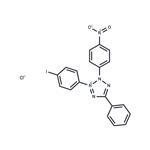Iodonitrotetrazolium (INT) (chloride) is a monotetrazolium salt used as an indicator dye. It is reduced to an insoluble formazan that is used as a vital dye or indicator of cellular redox activity. Reduction commonly results from the activity of dehydrogenases, although non-enzymatic electron transfer reactions can occur in the presence of an intermediate electron acceptor. INT is commonly used to measure the respiratory activity of microorganisms in a variety of contexts.
Iodonitrotetrazolium chloride (INT) on reduction gets converted to iodonitrotetrazolium formazan, a water insoluble violet colored dye or indicator. Hence INT can be used for the colorimetric assay of various dehydrogenases.
Iodonitrotetrazolium chloride has been used for the staining of cells. It has been used as a coupling agent in the enzymatic assay of D-arabinitol.
Electron acceptor for the colorimetric assay of various dehydrogenases.
ChEBI: An organic chloride salt having iodonitrotetrazolium as the counterion.
Iodonitrotetrazolium chloride could cause skin irritation, serious eye irritation, and may cause respiratory irritation.
Properties and Applications
INT (Iodonitrotetrazolium chloride), similar to tetrazolium chloride on reduction, produces a red formazan dye that can be used for quantitative redox assays. It is also toxic to prokaryotes.INT is an artificial electron acceptor that can be utilized in a colorimetric assay to determine protein concentration in a solution. It can be reduced by succinate dehydrogenase to furazan, the formation of which can be measured by absorbance at 490 nm. The activity of succinate dehydrogenase is readily observed by the naked eye as the solution turns from colorless to rusty red.
Recrystallise the chloride from H2O, aqueous EtOH or EtOH/Et2O. Alternatively, dissolve it in the minimum volume of EtOH and add Et2O; or dissolve it in hot H2O (charcoal), filter and precipitate it by adding conc HCl. Filter the solid off and dry it at 100o. Its solubility in H2O at 25o is 0.5%, and in hot MeOH/H2O (1:1) it is 5%. [Fox & Atkinson J Am Chem Soc 72 3629 1950, Beilstein 26 III/IV 1776.]


